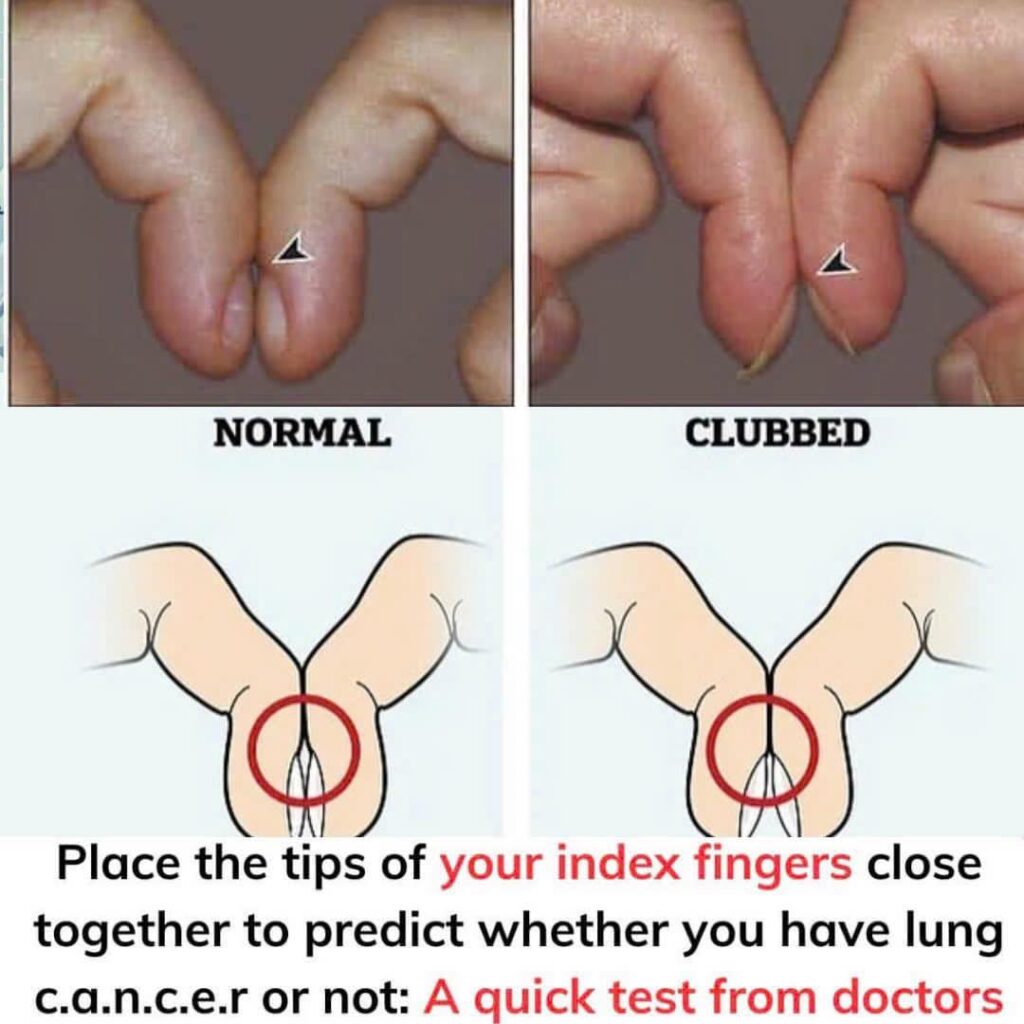You may not think much about the shape of your fingernails — but what if they could silently signal a serious medical issue? A subtle change in your fingertips could be your body’s quiet cry for help. That’s where the Schamroth Window Test comes in — a quick and easy self-check you can do at home to spot finger clubbing, a condition linked to various underlying diseases like lung cancer, heart disease, and chronic respiratory issues.
What Is Finger Clubbing?
Finger clubbing refers to noticeable changes in the appearance of your fingers and nails. Most often, it involves a widening or rounding of the fingertips and an increased curve of the nails. While the change may seem minor or cosmetic, it’s often a symptom of an underlying medical condition — not a standalone issue.
Clubbing tends to develop gradually and is usually triggered by low oxygen levels in the bloodstream over time. This drop in oxygen may be the result of diseases affecting the lungs, heart, liver, or digestive system.
The Schamroth Window Test: A Quick At-Home Screening
Doctors often rely on a simple, non-invasive test to detect finger clubbing: the Schamroth Window Test (also called the Schamroth Sign). Best of all? You can perform it in less than 30 seconds, right from home.
How to Perform the Test:
- Press the tips of your index fingers together so that the nails touch.
- Look closely at the space where the nails meet.
- Normal Result: You should see a small diamond-shaped gap or “window” of light between the nails.
- Abnormal Result: If no gap appears — meaning the nail beds press flat against one another — this could be a sign of finger clubbing.
This test doesn’t provide a diagnosis, but it may serve as a useful early-warning tool that prompts you to investigate further.
What Can Cause Finger Clubbing?
Finger clubbing is often the result of long-term, reduced oxygen supply to the fingers, which causes changes in the soft tissue under the nail bed. It doesn’t happen overnight — it progresses in stages and is usually associated with serious medical conditions. Here are some of the common causes:
1. Lung Cancer
This is one of the most well-documented links. Particularly in individuals who have persistent coughs, chest discomfort, or unexplained weight loss, clubbing can be a warning sign that the lungs aren’t functioning properly.
2. Chronic Lung Diseases
Conditions like COPD (chronic obstructive pulmonary disease), pulmonary fibrosis, and tuberculosis (TB) often lead to clubbing as oxygen delivery becomes less efficient.
3. Heart Conditions
Certain congenital heart defects, bacterial endocarditis, and heart diseases that limit oxygen circulation can cause finger clubbing, especially when the heart is unable to deliver adequate oxygenated blood to the extremities.
4. Liver Disease
Cirrhosis, particularly biliary cirrhosis, may also cause clubbing due to altered blood flow and decreased oxygenation. The liver’s compromised ability to filter and detoxify the blood can create widespread systemic effects.
5. Digestive Disorders
Surprisingly, gastrointestinal issues such as Crohn’s disease, ulcerative colitis, and cystic fibrosis can sometimes lead to finger clubbing. These chronic conditions create systemic inflammation, which may disrupt the oxygen balance in the blood.
When Should You Seek Medical Advice?
While finger clubbing alone isn’t enough to diagnose a condition, it can serve as a red flag that something more serious might be going on — especially if paired with other symptoms. If you notice the absence of the diamond-shaped window during the Schamroth Test, and you’re also experiencing any of the following signs, it’s time to talk to a healthcare provider:
- Persistent cough, especially if it worsens or produces blood
- Unexplained fatigue or extreme tiredness
- Shortness of breath or difficulty breathing
- Ongoing chest pain or tightness
- Sudden or gradual weight loss without dietary changes
Early intervention could make a significant difference in outcomes, particularly for conditions like lung cancer, which is often diagnosed too late.
Is Finger Clubbing Reversible?
The short answer: No, not directly. Once the shape of your fingers changes due to clubbing, those physical alterations are typically permanent. However, if the underlying health issue is identified and treated early, further progression can often be stopped or slowed down.
For instance, treating the source of poor oxygenation — whether it’s a lung tumor, heart valve defect, or liver disorder — can prevent clubbing from worsening and may improve overall health and quality of life.
Why the Schamroth Test Matters in Everyday Health
In a world full of complicated health tests and high-tech diagnostics, it’s refreshing — and powerful — to have a tool as simple as the Schamroth Window Test. It requires no special equipment, takes less than a minute, and could uncover early signs of life-threatening illness.
While it’s not a substitute for professional medical evaluation, using this test periodically — especially if you have risk factors for lung or heart disease — is a smart way to stay aware of your health.
Final Thoughts: Don’t Overlook What Your Body Is Trying to Tell You
Your body is always sending signals. Some are loud and obvious, others are subtle — like a shift in the shape of your fingertips. Performing the Schamroth Window Test can be a first step toward recognizing those silent signs and seeking the care you might need.
If you notice finger clubbing or other worrying symptoms, don’t delay. Speak with a doctor and consider additional testing. When it comes to diseases like lung cancer or chronic heart failure, early detection can save lives.


